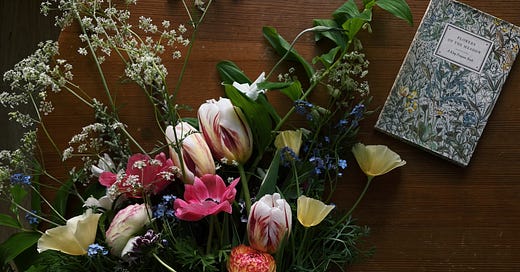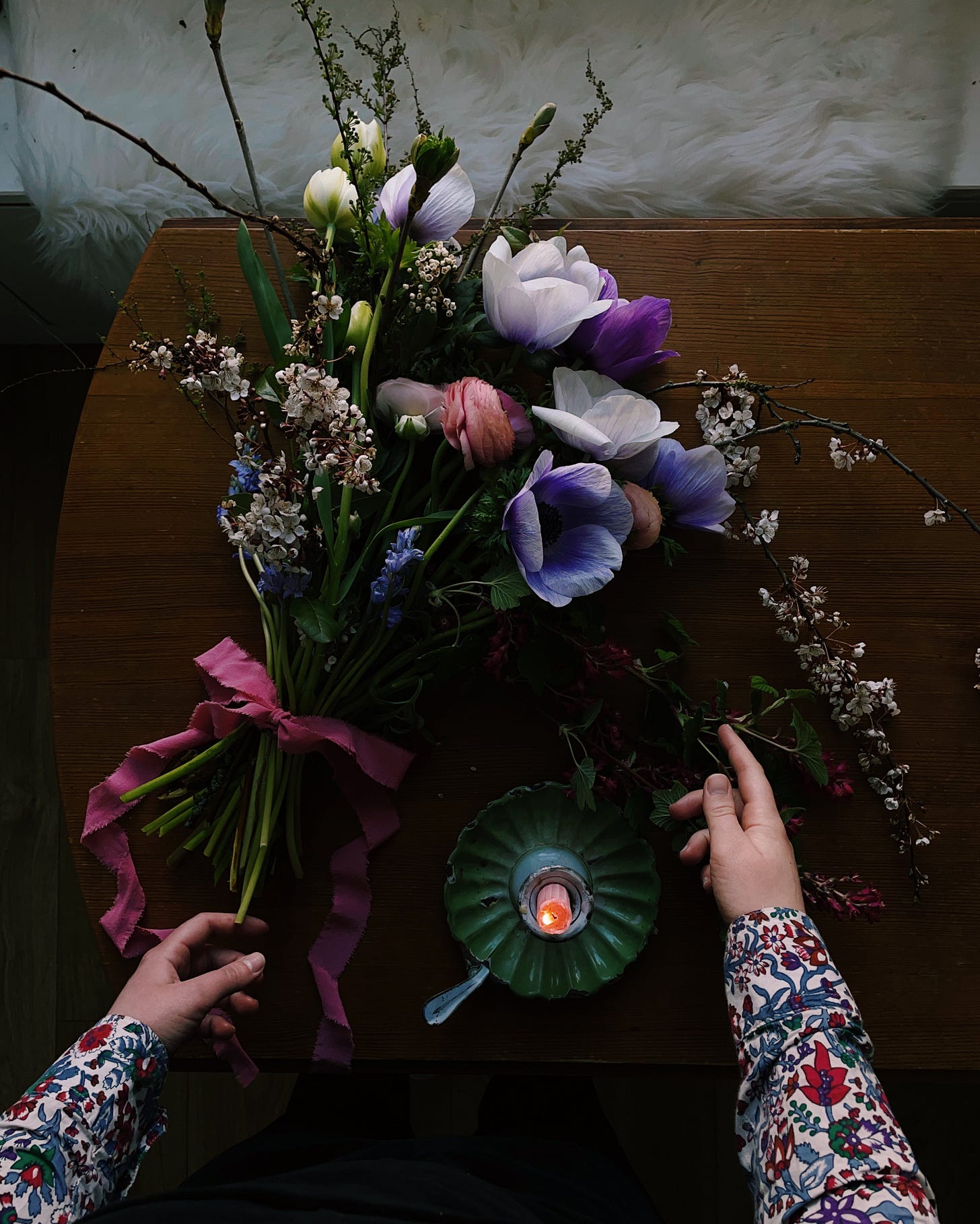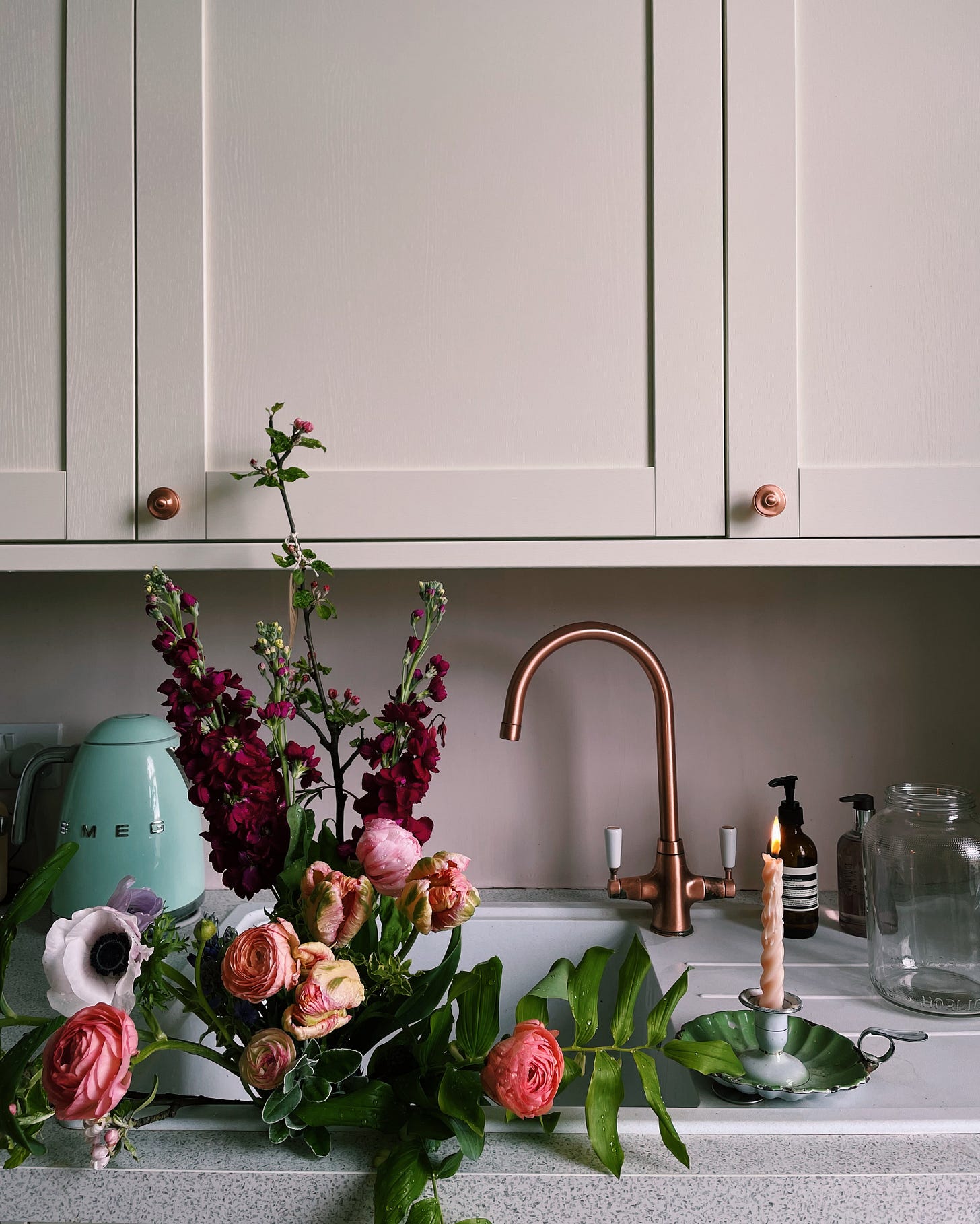“Buy flowers — or if you are poor, steal one from someone’s garden; the world owes you that much at least: a blossom — and put them at the end of the bed. When you wake, look at them, and tell yourself you are the kind of person who wakes up and sees flowers. This stops your first thought being, “I fear today. Today is the day maybe I cannot survive anymore,” which I know is what you would otherwise think. Thinking about blossoms before you think about terror is what girls must always do, in the Bad Years.” Caitlin Moran, ‘Moranifesto’.
While I’m not condoning floral theft, Caitlin Moran’s exaggeration makes a vital point about the healing power of flowers, nature and our mindsets. When I first read it, I was at a really low point and I remember it made me cry a lot as it really resonated. I’m not about to say that flowers will cure all your ills, but over the years I’ve learned so much from nature, the rhythms of the year and their small joys that, to me, added together to give me meaning and hope - and that’s what this newsletter is all about.
The presence of flowers has been proven scientifically to have mood boosting benefits. I know some people think they’re a faff to look after (and I do understand that perspective), but I’m the kind of person that needs to look after things and has a lot of love to give. I know they’re a luxury, but treating myself to flowers is one of my mental health essentials, especially living in a flat without access to a garden of my own. My flower subscription from Pyrus and my eucalyptus subscription from Gloam were a saviour over lockdowns (I can’t wait to start up the former when we move).
The growing season is well underway in the UK and this means locally grown blooms are plentiful once again. For more affordable options, get in touch with a local florist or grower and give them a budget to work to (you’d be surprised at how much cheaper the flowers can be if they’ve not travelled far) and it’s great to see supermarkets stocking British flowers for more accessible prices too. Blooms like Sweet Williams cost a few pounds and last for a good couple of weeks if you look after them; what’s more, their mood-lifting properties are priceless.
Here are some tips I’ve gathered over the years for arranging flowers yourself at home - this certainly cuts the price if you’re buying stems from a florist rather than an arrangement, and can make the most of simple supermarket flowers too.
1) Firstly, prepare your receptacle. Over the years I’ve collected all manner of receptacles to choose from - everything from 50p flea market Victorian ink bottle finds to enamelware jugs unearthed in charity shops. I tend to reach for my giant Kilner jars again and again; I just adore their vintage lettering and versatile shape. Flowers require crystal clear water so make sure your vase isn’t dirty – I add a drop of bleach to remove any residue, rinse, then add fresh water. You don’t need to fill it all the way up with water otherwise you will drown the flowers.
2) When you receive your cut flowers, unpack them to let them breathe (most flowers are cut when they are sleeping in the early morning and will wake up in the water!). Before you add each stem to the vessel, trim their ends on the diagonal to increase the surface area available for the flowers to take up maximum water. Remove all greenery that will sit below the water line as it will die and pollute your water, making your arrangement deteriorate faster.
3) I like to lay all my stems out in front of me to see the different sizes and shapes I’ve got to work with. Begin with a thick stem of foliage and cross with another long, thick stem, turn the vase, criss-cross two smaller stems and so on. This will create a tepee shape so that your flowers are supporting themselves – rather than the neck of the vase. Keep threading them through, making sure that weaker, soft stems, such as tulips, are in the centre and thus supported by the arrangement and less likely to flop over. Work with the different shapes and heights and don’t be too precious – rustic is in (thank goodness!). Play, learn and enjoy the process - it’s half the fun.
4) Once your arrangement is ready, add flower food or a drop – and I mean a drop – of bleach and a pinch of sugar to perk them up. Always keep your blooms away from direct sunlight, sources of heat (or cold) and also, perhaps surprisingly, fruit – as they give off ethylene gas that can cause flowers to deteriorate. To stop tulips flopping, a couple of copper coins in your water will magically make them stand up!
To make them last:
Change your flower water every two to three days, and each time you do, trim the ends a little more. You will be left with much shorter stems by the time your flowers are done but they will last much longer as a result. Make sure you remove any stems that die off, as they will cause the other flowers to die too. Your arrangement will evolve, but I love ending up with lots of wee posies here and there, filling every room and eking out my bunch of flowers for as long as possible.
Foliage and hardier stems last particularly well and will dry out, too. Once dried, they last a lifetime; as such they lend themselves well to things like flower crowns that can be dried and worn again.
So here’s your permission slip, if you need it: buy the flowers.







Wonderful tips thank you 😊
Beautiful!